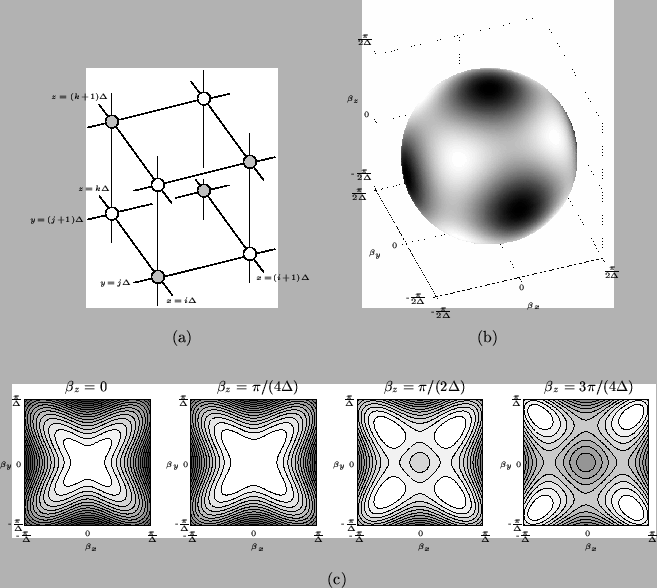


Next: The (3+1)D Interpolated Rectilinear
Up: Finite Difference Schemes for
Previous: The Cubic Rectilinear Scheme
The Octahedral Scheme
The grid for an octahedral scheme is constructed from two superimposed rectilinear grids; if the points of the first grid are located at cube corners, then the points of the second will occur at the centers of the cubes defined by the first. The relevant difference scheme on an octahedral grid can be written as
 |
(A.30) |
for  ,
,  and
and  which are either all even or all odd integers. Now, we have taken the spacing between nearest neighbors to be
which are either all even or all odd integers. Now, we have taken the spacing between nearest neighbors to be  , so the indices
, so the indices  ,
,  and
and  refer to a point with coordinates
refer to a point with coordinates
 ,
,
 and
and
 . The amplification polynomial equation is again of the form (A.5), with
. The amplification polynomial equation is again of the form (A.5), with
and
and it is again easy to determine that
which are the same as the bounds in the cubic rectilinear case. We again have that
 (for Von Neumann stability) (for Von Neumann stability) |
|
Thus the stability bound coincides with the passivity bound for the mesh implementation. For
 , instabilities may appear at any spatial frequency triplets
, instabilities may appear at any spatial frequency triplets

![$ = [\beta_{x}, \beta_{y}, \beta_{z}]^{T}$](img3045.png) where each component is either 0 or
where each component is either 0 or
 .
.
The computational and add densities are given by
At the stability limit, the scheme can be divided into two mutually exclusive subschemes; plots of numerical dispersion are shown in Figure A.9(b) and (c). It is interesting to note that there is no dispersion error along the six axial directions; this should be compared with the cubic rectilinear scheme, for which wave propagation is dispersionless along the diagonal directions (there are eight such directions).
Figure A.9:
The octahedral scheme (A.29)-- (a) numerical grid and connections, where grey/white coloring of points indicates a division into mutually exclusive subschemes at the stability bound; (b)
 for the scheme at the stability bound
for the scheme at the stability bound
 , for a spherical surface with
, for a spherical surface with


 --the shading is normalized over the surface so that white corresponds to no dispersion error, and black to the maximum error over the surface (which is 5 per cent in this case). (c) Contour plots of the
--the shading is normalized over the surface so that white corresponds to no dispersion error, and black to the maximum error over the surface (which is 5 per cent in this case). (c) Contour plots of the
 for various cross-sections of the space of spatial frequencies
for various cross-sections of the space of spatial frequencies
 ; contours indicate successive deviations of 2 per cent from the ideal value of 1 which is obtained at spatial DC.
; contours indicate successive deviations of 2 per cent from the ideal value of 1 which is obtained at spatial DC.
 |



Next: The (3+1)D Interpolated Rectilinear
Up: Finite Difference Schemes for
Previous: The Cubic Rectilinear Scheme
Stefan Bilbao
2002-01-22





